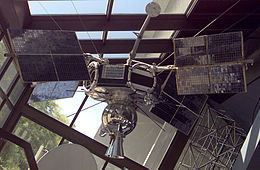Operator NASA SATCAT no. 2258 Period 27 days Rocket Delta E Last contact 21 September 1971 | COSPAR ID 1966-058A Inclination 24.4° Launch date 1 July 1966 Manufacturer NASA | |
 | ||
Mission type Magnetospheric research Mission duration 1,876 days (5 years, 1 month and 21 days) Launch mass 212.0 kilograms (467.4 lb) Similar Explorer 35, Explorer 49, Explorer 11, Explorer 8, Student nitric oxid | ||
Explorer 33 (also known as AIMP-D or IMP-D) was a spacecraft in the Explorer program launched by NASA on July 1, 1966 on a mission of scientific exploration.
Orbit
Originally intended for a lunar orbit, mission controllers worried that the spacecraft's trajectory was too fast to guarantee lunar capture. Consequently, mission managers opted for a backup plan of placing the craft into an eccentric Earth orbit with a perigee of 265,679 km and an apogee of 480,762 km — still reaching distances beyond the Moon's orbit.
Despite not attaining the intended lunar orbit, the mission met many of its original goals in exploring solar wind, interplanetary plasma, and solar X-rays. Principal investigator James Van Allen used electron and proton detectors aboard the spacecraft to investigate charged particle and X-ray activity. Astrophysicists N. U. Crooker, Joan Feynman, and J. T. Gosling used data from Explorer 33 to establish relationships between the Earth's magnetic field and the solar wind speed near Earth.
